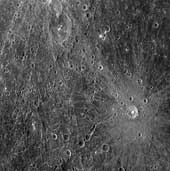|
COMETS EARTH JUPITER KUIPER BELT MARS MERCURY METEORITES NEPTUNE OORT CLOUD PLUTO SATURN SOLAR SYSTEM SPACE SUN URANUS VENUS ORDER PRINTS
PHOTO CATEGORIES SCIENCEVIEWS AMERICAN INDIAN AMPHIBIANS BIRDS BUGS FINE ART FOSSILS THE ISLANDS HISTORICAL PHOTOS MAMMALS OTHER PARKS PLANTS RELIGIOUS REPTILES SCIENCEVIEWS PRINTS
|
Related Documents
Download Options
During its flyby of Mercury, the MESSENGER spacecraft acquired high-resolution images of the planet's surface. This image, taken by the Narrow Angle Camera (NAC) on the Mercury Dual Imaging System (MDIS), was obtained on January 14, 2008, about 37 minutes after MESSENGER's closest approach to the planet. The image reveals the surface of Mercury at a resolution of about 360 meters/pixel (about 1180 feet/pixel), and the width of the image is about 370 kilometers (about 230 miles). This image is the 98th in a set of 99 images that were taken in a pattern of 9 rows and 11 columns to enable the creation of a large, high-resolution mosaic of the northeast quarter of the region not seen by Mariner 10. During the encounter with Mercury, the MDIS instrument acquired image sets for seven large mosaics with the NAC. This image shows a previously unseen crater with distinctive bright rays of ejected material extending radially outward from the crater's center. A chain of craters nearby is also visible. Studying impact craters provides insight into the history and composition of Mercury as well as dynamical processes that occurred throughout our Solar System. The MESSENGER Science Team has begun analyzing these high-resolution images to unravel these fundamental questions. Credit: NASA/Johns Hopkins University Applied Physics Laboratory/Carnegie Institution of Washington |
